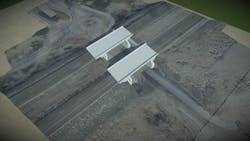Rebuilding Bridges for Movement
Key Takeaways
- UDOT is replacing three aging, structurally deficient bridges at the I-84/I-15 interchange using accelerated bridge construction (ABC) to minimize disruptions and improve mobility.
- Stanley Consultants designed the new bridges for the lateral slide technique, allowing weekend installation while maintaining weekday traffic and ensuring safety for both crews and drivers.
- The wider, longer replacements are built to current standards and future growth needs, reflecting UDOT’s people-first approach to mobility and innovation in bridge engineering.
By Joseph Lowrance and Dan Shiosaka, Contributing Authors
As the Utah Department of Transportation (UDOT) sets out to replace aging infrastructure on the interchange of Interstate-84 and Interstate-15 in a suburb north of Salt Lake City, improving mobility is at the heart of their approach.
Three existing bridges, two on I-84 and one on 4400 South over I-15, are structurally deficient, with one instance in which a large area of concrete fell from the deck.
The I-84 bridge designs were initially approved in 1964, making these bridges more than 60 years old. Flanked by Hill Air Force Base, Ogden-Hinkley Airport and the region’s hospital network, limiting traffic disruptions while expediting the bridge replacement is paramount to public safety and business operations.
UDOT decided that an accelerated bridge construction (ABC) is needed for this project.
ABC for Seamless Travel
Stanley Consultants designed the bridge replacements specifically for the ABC lateral slide technique, which reduces traffic disruptions, accelerates the schedule and maximizes safety for crews and drivers.
Unlike traditional bridge construction, which often requires extensive lane closures, prolonged detours or temporary structures, the lateral slide approach simplifies maintenance of traffic and minimizes iterative traffic control needs.
The two I-84 bridges are engineered to be built adjacent to the existing spans and slid into place during weekend closures, enabling UDOT to maintain traffic flow during the critical weekday commute.
These spans are designed to be built in parallel with existing bridges, meaning the horizontal and vertical alignments are consistent with the existing structures to reduce closure time.
The dual single-span bridges feature parallel collinear abutments with identical plan geometry and matching ABC runway paths for sliding into place. To maintain the 16.5-foot minimum vertical clearance, the eastbound structure will be built higher than its final elevation. It will then be lowered before it is slid into place.
Resilience and Growth
Each of the three bridge replacements are wider than its predecessors. The I-84 bridges each gain an additional 4 feet of roadway width, enabling the bridges to meet design standards with wider shoulders.
The new 4400 South bridge over I-15 is 28.5 feet wider than its predecessor. This accommodates Riverdale’s future four-lane roadway section.
The bridges are longer to accommodate future roadway widening of I-15 and 4400 South. UDOT Project Manager Corey Nelson, Riverdale officials and Stanley coordinated this forward-looking design.
The new 71-foot-long, single-span I-84 bridges are designed so the new abutments fit within the 29.5-foot-long end spans of the original structures. A constant 10.2-degree skew maintains consistent geometry..
However, limited space beneath the existing bridges posed a significant engineering challenge. Stanley addressed this by designing 16-inch diameter, reinforced concrete-filled driven piles located outside the deck footprint. This transferred loads through deep-beam abutments and outboard pile groups.
Geotechnical challenges, including soft clay soils from an ancient lakebed and high seismic loads, prompted further pivots to the design. Flowable fill behind the abutments will be used to speed construction and regulate earth pressure through passive soil pressure.
Community-Focused Approach
Monthly coordination meetings with Riverdale kept all parties aligned on aesthetics and other items, such as reusing decorative soil wall art.
In alignment with the engineering specifications, close communication with the local fire department will maintain emergency access during closures and the Utah Transit Authority will be looped in to minimize impacts on public transit.
Stanley treated mobility as more than just vehicle flow but instead accounted for the people element — how they move, how they commute and how their lives continue during construction.
“Mobility isn’t just about traffic,” said Heather Jones, Stanley’s project manager. “It’s about people. How they commute. How emergency services respond. How we can work to improve their lives—not interrupt them.”
Stanley’s work reflects the Federal Highway Administration’s Every Day Counts and a broader trend across UDOT and the nation: ABC methods are increasingly utilized in high-traffic areas. By leveraging ABC methods and components like partial-depth precast concrete panels, high-performance concrete joints and lateral bridge slides, ABC projects can simplify inspection, improve safety, reduce construction timelines and reduce traffic impacts.
The future construction of the bridge replacements will bring to life a vision that merges engineering excellence with mobility foresight.
Joseph Lowrance, PE, SE is the U.S. Transportation and Structural Group Manager for Stanley Consultants. Dan Shiosaka, PE, SE serves as a Principal Structural Engineer with Stanley Consultants.
